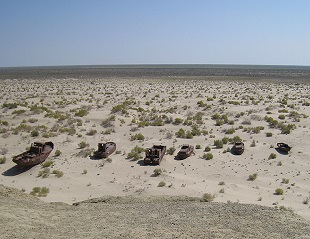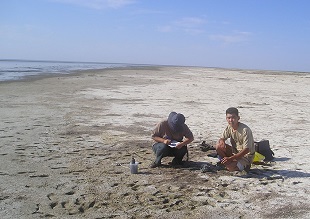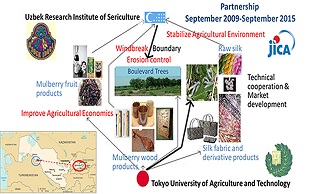中央アジアの環境問題

メンバー: 川端良子、山田祐彰
分野: 環境保全学、水圏応用科学、環境解析学
所属: 農学研究院、国際センター
キーワード: 中央アジア、ウズベキスタン、アラル海、水質汚染、農業、農村復興、養蚕業
ウェブサイト:
研究概要

1)アラル海問題
アラル海問題は、世界的な環境問題の一つとして知られています。1950年代から行われた河川水を利用した沙漠での大規模灌漑農業により、アラル海の縮小は起こりました。その結果、それまで沙漠だった地域に、多くの都市や村がつくられ、人々は綿花栽培を中心に、米、小麦、野菜、果樹の栽培を行っています。
20世紀後半からのアラル海の縮小により、アラル海集水域の気候が大きく変化し、特に、カラカルパキスタン自治州に大きな被害をもたらしています。
この集水域の飲料水の起源は、地下水と河川水です。アラル海の縮小は、地下水にも大きな影響を与えています。そこで、私達は、アラル海の縮小が、アラル海周辺の水質にどのような影響を与えたかについて研究しています。
2)養蚕業によるウズベキスタンの地域開発
ウズベキスタンでは、国民の40パーセントが農業に従事していますが、地方と都市との所得格差が拡大しています。ウズベキスタンでは、ソビエト連邦時代にアムダリヤ川とシルダリヤ川の水を使った大規模潅漑ネットワークにより大規模な綿と穀物の生産を開始しました。
しかし、ウズベキスタンの農業は、単一栽培に基づく不安定な経済、地下水と土の汚染とアラル海の後退に至った過剰な水利用による農地の劣化を招きました。
一方、ウズベキスタンには、絹産業で数千年の歴史があります。繭生産量は、中国、インドに続く第3位です。しかし、その養蚕と製糸の技術は、ソビエト連邦の崩壊の後落ちました。大部分の繭が安値で買い上げられるので、農民は養蚕業への意欲を失いつつあります。このような背景のもと、プロジェクトでは、高品質絹を生産することができる日本の蚕を導入することによってウズベキスタンで地方の生計の改善が期待されます。
主要論文・参考事項
1) Aral Sea Desertification Caused by Irrigation and Its Effects on Water Quality, Journal of Arid Land Studies, vol. 5, pp.255-258 (1995).
2) The Phytoplankton Flora of Saline Lakes in Central Asia, International Journal of Salt Lake Research, vol. 6, pp.5-16 (1997).
3) Uranium Pollution in Republic of Uzbekistan, Journal of Arid Studies, vol. 13-4,pp.227-233 (2004)
4) Uranium and thorium isotopes from Kazakhstan, Journal of Radioanalytical and Nuclear Chemistry, vol.278, No.2,pp.489-462(2008)
5) Seasonal Changes in Water Quality of Rivers and Ground Water in Karakalpakstan, Uzbekistan, Journal of Arid Land Studies, Vol.22, No.1, pp.171-174(2012)
6) Water Quality in the Lake Issyk-kul and the River Flowing into it, Journal of Arid Land Studies Vol.24, No.1, pp.105-108(2014)
7) Revitalizing rural areas through modernized sericulture - A Case Study in Fergana Region, Uzbekistan, Journal of Arid Land Studies Vol.24, No.1, pp.179-182(2014)
お問い合わせ先
東京農工大学・先端産学連携研究推進センター
urac[at]ml.tuat.ac.jp([at]を@に変換してください)
Environmental Problem in Central Asia

Research members: Dr. Yoshiko Kawabata, Masaaki Yamada PhD.
Research fields: Environmental conservation, Applied aquatic science, Environmental analyses and evaluation
Departments: International Center, Institute of Agriculture
Keywords: Central Asia, Uzbekistan, Aral Sea, Water pollution, Agriculture, Rural Development, Sericulture
Web site:
Summary

1)Aral sea Problem
The Aral Sea Problem is now regarded as one of the serious environmental problems in the world. The decrease in Aral Sea area was caused by irrigated agriculture on a large scale which started in the 1950’s, especially in the Aral Sea basin. As the result, many villages were built in the area and people started production activities such as cotton growing, wheat and vegetables.
The gradual climate change over the centuries was accelerated by the ecological disaster of the Aral Sea which took place in the late 20th century in Aral Sea basin, especially in Karakalpakstan.
Ground water or river water is the main source of drinking water in this basin. We are researching changes in water quality.
2)Rural development using sericulture in Uzbekistan
The rural-urban income disparities have been expanding in Uzbekistan , while forty percent of the nation is still engaged in farming. Since the time of the Soviet Union, the Uzbek agriculture has specialized in large-scale cotton and cereal production thanks to the Soviet-built irrigation network fed by the Amu Darya and Syr Darya Rivers. However, the Uzbek farms have faced challenges such as an unstable economy based on monoculture, contamination of groundwater and soil, and depletion of the rivers by excess water intake that led to regression of the Aral Sea.
Uzbekistan has several thousand years of history in the silk industry. It is still ranked third after China and India in cocoon production, but its sericulture and filature has declined after collapse of the Soviet Union due to hiatus of technology development. Farmers are less willing to produce silk because most of cocoons are traded at low prices. With this backdrop a project is planned to improve the rural livelihood in Uzbekistan by introducing Japanese silk worm breeds capable of producing high quality silk.
Reference articles and patents
1) Aral Sea Desertification Caused by Irrigation and Its Effects on Water Quality, Journal of Arid Land Studies, vol. 5, pp.255-258 (1995).
2) The Phytoplankton Flora of Saline Lakes in Central Asia, International Journal of Salt Lake Research, vol. 6, pp.5-16 (1997).
3) Uranium Pollution in Republic of Uzbekistan, Journal of Arid Studies, vol. 13-4,pp.227-233 (2004)
4) Uranium and thorium isotopes from Kazakhstan, Journal of Radioanalytical and Nuclear Chemistry, vol.278, No.2,pp.489-462(2008)
5) Seasonal Changes in Water Quality of Rivers and Ground Water in Karakalpakstan, Uzbekistan, Journal of Arid Land Studies, Vol.22, No.1, pp.171-174(2012)
6) Water Quality in the Lake Issyk-kul and the River Flowing into it, Journal of Arid Land Studies Vol.24, No.1, pp.105-108(2014)
7) Revitalizing rural areas through modernized sericulture - A Case Study in Fergana Region, Uzbekistan, Journal of Arid Land Studies Vol.24, No.1, pp.179-182(2014)
Contact
University Research Administration Center(URAC),
Tokyo University of Agriculture andTechnology
urac[at]ml.tuat.ac.jp
(Please replace [at] with @.)



